Sanhe Ancient Town Scenic Area is located in Feixi County, Hefei City, Anhui Province, on the bank of Chaohu Lake, adjacent to Lujiang County and Shucheng County. It has long been known as "One step across three counties, and the crowing of chickens can be heard in three counties". The total area of the ancient town is 2.9 square kilometers, and the scenic area covers about 2 square kilometers. With a history of more than 2,500 years, Sanhe Ancient Town is a national 5A-level tourist attraction. The town gets its name from three rivers—the Fengle River, Hangbu River and Xiaonan River—that flow through it. Featuring a water town style, it boasts abundant cultural landscapes and forms the unique "Eight Ancient Sceneries" in the Jianghuai region, namely ancient rivers, ancient bridges, ancient dikes, ancient streets, ancient residences, ancient teahouses, ancient temple platforms and ancient battlefields. There are a large number of ancient buildings from the late Qing Dynasty and the Republic of China, with architectural styles combining northern and southern characteristics, mostly mixed wooden and brick-stone structures. It is one of the water towns with the architectural style of central Anhui in the late Qing Dynasty.
History and Culture
Sanhe Ancient Town has a long history. More than 2,550 years ago, it was originally a highland emerging from Chaohu Lake, a habitat for magpies, and was historically known as "Quezhu" and "Que'an". The town initially took shape during the Spring and Autumn Period and the Warring States Period, when the Battle of Que'an between the Wu and Chu states took place here. After the Qin Dynasty unified China, Sanhe was under the jurisdiction of Jiujiang Commandery, and during the Han Dynasty, it was governed by Lujiang Commandery. In the Three Kingdoms Period, Cao Cao once trained his navy here. After the Eastern Jin Dynasty, its jurisdiction changed frequently, mostly belonging to the Eastern Jin, the Liu Song, Qi, Liang and Chen dynasties of the Southern Dynasties, and it was once named "Quewei" and "Sanchakou River" during this period. At the beginning of the Sui Dynasty, Luzhou was established, and since then Sanhe has been under the jurisdiction of Luzhou. In the Tang Dynasty, during the reign of Emperor Xuanzong, the original land of Shu County was divided into Lujiang County and Shucheng County. From then until the Republic of China, Sanhe was located at the junction of Hefei, Shu County and Lujiang County. At the end of the Ming Dynasty, Zhang Xianzhong's uprising army once organized a navy in Sanhe. Sanhe Town was set up during the Ming and Qing dynasties. At the end of the Qing Dynasty, the Battle of Sanhe, in which the Taiping Army defeated the Qing army, took place here. Sanhe Ancient Town had a developed shipping industry and was once an important commodity distribution center, known as "Sanhe with endless goods to buy, the commodity corridor in central Anhui". During the War of Resistance Against Japanese Aggression, a large number of people poured in to promote commercial development, and it was known as "Little Nanjing". During the Liberation War, its commerce was hit and declined day by day. After the founding of the People's Republic of China, commerce recovered. After the reform and opening up, with the development of land transportation and the decline of water transportation, the commercial and trade status of the ancient town decreased. However, its industrial development started early. Before liberation, more than ten industrial factories in fields such as textiles, cigarettes and food had been formed, with about 20 kinds of products exported abroad, and later it gradually transformed into an industrial and trade town.
Main Attractions
Daifu Di (Doctor's Mansion)
It was the private residence of civil officials during the Ming and Qing dynasties. It displays furniture and architectural components from the Ming and Qing dynasties. Highlights include the plaque "Daifu Di" inscribed by Zhu Fengbiao, the Minister of Five Ministries (Ministry of Works, Ministry of Punishments, Ministry of Revenue, Ministry of War, Ministry of Personnel) in the sixth year of the Tongzhi reign, an integral square table made of cherry wood from the Ming Dynasty, red sandalwood and rosewood round-backed armchairs, nanmu cabinets, golden nanmu canopy beds, and ancestral portraits from the early Qing Dynasty.

Liu Tongxing Longzhuang (Liu Tongxing Prosperous Manor)
Sanhe has been a thoroughfare of water and land transportation since ancient times, known as "the commodity corridor in central Anhui". Liu Tongxing Longzhuang was the shop of Liu Jintang, the president of the Sanhe Chamber of Commerce in the late Qing Dynasty. At that time, it was crowded with customers and enjoyed booming business, hence the trade name "Tongxinglong" (meaning common prosperity). The entire manor consists of five courtyards, eight wing-rooms and thirty-two houses. The street-facing part is a two-story wooden building, the second courtyard is a revolving wooden corridor building, and the last three courtyards are bungalows. The third courtyard is an open hall for receiving guests; the fourth is a memorial hall for worshipping ancestors; the fifth is a residential area, with a construction area of about 700 square meters.
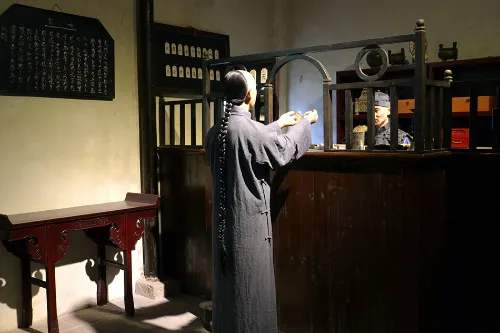
Dong Yinchu Memorial Hall
Mr. Dong Yinchu was born in Sanhe in 1915. He pursued truth all his life and maintained a profound friendship with the Communist Party of China. His memorial hall is located on the ancient West Street of Sanhe Town, consisting of five courtyards. The exhibition hall showcases his selfless and fearless life through texts, pictures, cultural relics and wax figures.
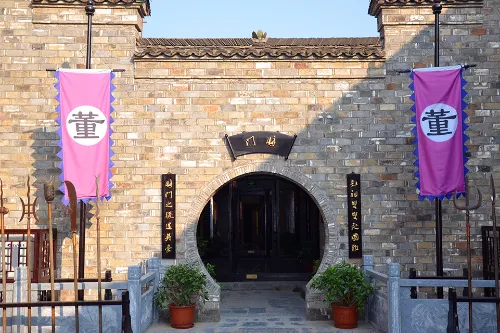
Yang Zhenning's Former Residence
It is a Huizhou-style mansion first built during the Ming and Qing dynasties, with five courtyards in front and back, adjacent to "One-Man Lane". Professor Yang Zhenning lived and studied here with his mother in his childhood, and the former residence is filled with traces of his diligent study.
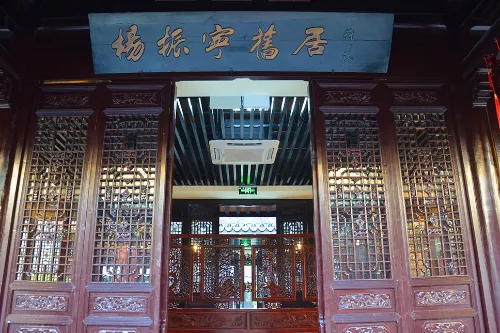
Sun Liren's Former Residence
Sun Liren was a famous anti-Japanese general and a senior general of the Kuomintang. Born in Sanhe in 1900, the Sun family owned thousands of mu of fertile land and hundreds of houses in Sanhe. The well from which the general fetched water in his childhood is still preserved in the former residence.
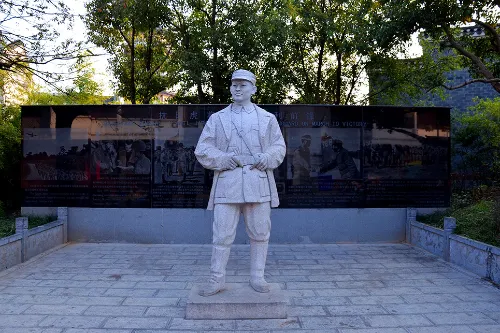
Helu (Crane Cottage)
This is the former residence of Liu Bingzhang, a general of the Huai Army. Liu Bingzhang, a native of Sanhe, was a trusted aide of Li Hongzhang. He once led troops to repel the French army and defeat the Nian Army, and successively served as the governor of Jiangxi, Zhejiang and Sichuan provinces. He once owned more than a hundred mansions in Sanhe, and this one was renovated later.
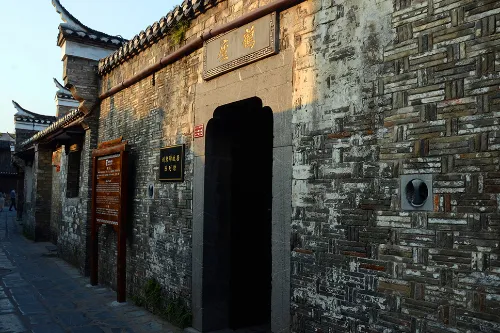
Xianggu Lou (Fairy Maiden Tower)
In 1898, Shi Daosheng, Peng Zhongqiao and Wang Liangzhi jointly invested in the food industry and officially founded "Zhonghexiang". Shi Daosheng was an honest and kind man, who was dedicated to integrity. Believing in the Buddhist karma of "good deeds bring good rewards", he kept incense burning all year round and his whole family worshipped devoutly. The owner of "Jinjufeng", a giant in the department store industry of Sanhe, was on good terms with Shi Daosheng. Influenced by him, he gathered various business firms to build the "Xianggu Lou" completely, cast a golden statue of the fairy maiden, set up an incense table, lit candles, offered tribute cakes, burned incense morning and evening, and kowtowed at dawn and dusk. Although Mr. Jin Zhuzhai was extremely wealthy, he was troubled by having no daughter. On the Mid-Autumn night of that year, he led his wife and family to wash their hands, wear plain clothes, burn incense and kowtow to pray for a daughter. The next year (1903), his wife gave birth to a daughter, named "Qigu" (the Seventh Maiden). Since then, Xianggu Lou has become famous far and wide, attracting devout men and women from Shucheng, Tongcheng, Lujiang counties as well as Liu'an, Hefei, Wuhu and other places in an endless stream. The existing "Xianggu Lou" basically retains its original appearance, and the stone tablet inscribed "Bo Xin Ji Shi" (Helping the World with a Compassionate Heart) carved in the 25th year of the Republic of China still exists.
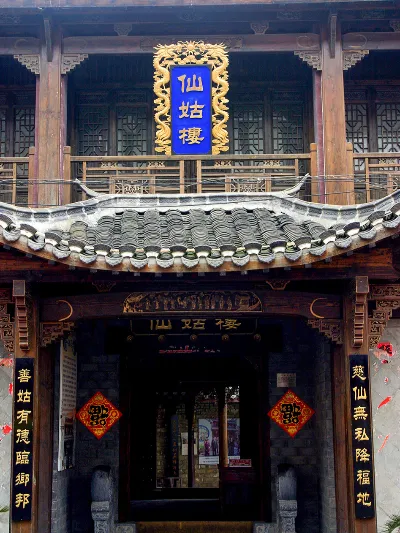
Wangyue Ge (Moon-Watching Pavilion)
Also known as "Guocui Lou" (Essence of Chinese Culture Tower), it is a seven-story ancient pagoda 37 meters high, located on the bank of Xiaonan Lake, and is one of the landmark buildings of the ancient town. There is an exhibition hall in the pavilion, displaying nearly a thousand pieces of ancient art treasures collected by the local people of Sanhe Ancient Town. The second floor exhibits plaques of different styles from past dynasties, the third floor displays red lacquered carved gilded furniture from the Qing Dynasty, the fourth floor shows plaques of officials and celebrities as well as stone carvings, the fifth floor mainly displays official plaques, the sixth floor mainly exhibits tin daily necessities such as wine pots from the Tang and Song dynasties and tin pots from the Qing Dynasty, and the seventh floor displays Buddha statues from various dynasties.

Sanhe Battle Memorial Hall
In 1858, the Taiping Army defeated more than 6,000 soldiers of the Xiang Army in Sanhe, a battle historically known as the "Great Victory of Sanhe". The Sanhe Battle Memorial Hall is a site where the Taiping Army was stationed, preserving the original surrounding walls and wells from that time. Covering an area of 2,200 square meters, the exhibition hall has abundant historical materials and a magnificent momentum, completely reproducing that turbulent period of history.
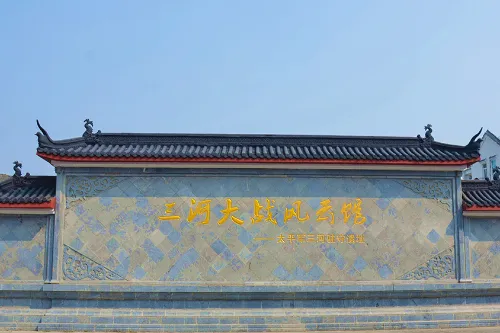
One-Man Lane
Tall ancient gable walls separate the buildings on both sides, leaving only enough space for one person to pass through, hence the name One-Man Lane. It was the path that the scientific giant Professor Yang Zhenning had to pass four times a day when he studied in Sanhe, and it has become a popular check-in spot for tourists.
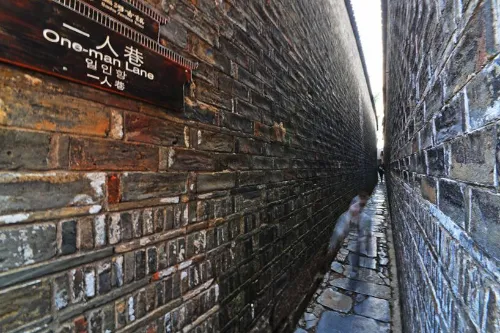
Tour Route
You can enter through the Dajie Gate (Victory Gate), first visit the former Yingwang Mansion to learn about the history of the Taiping Heavenly Kingdom period; then go to the ancient city wall of the Taiping Heavenly Kingdom to feel the atmosphere of the ancient battlefield; next head to Wannian Platform to appreciate the charm of the central point of the ancient town; afterwards walk along the ancient street and visit attractions such as Dong Yinchu Memorial Hall, Yang Zhenning's Former Residence, One-Man Lane and Xianggu Lou in turn; finally come to Wangyue Ge, climb the pavilion to overlook the whole view of Sanhe, and end the trip. On the way, you can also admire the ancient bridges on the Xiaonan River and experience the charm of the water town ancient town.
Travel Tips
- Arrange 1-2 days for the trip to fully appreciate the charm of the ancient town.
- You can choose to stay in characteristic homestays in the ancient town to experience the local living atmosphere.
- Taste local special snacks, such as Sanhe rice dumplings, dried tea tofu, rice wine, etc.
- If you are interested in history and culture, you can hire a tour guide to get a deeper understanding of the historical and cultural connotation of the ancient town.
Notes
- When visiting the ancient street, please protect the ancient buildings and do not touch or damage them at will.
- Take sun protection and anti-mosquito measures when visiting in summer.
- Pay attention to safety when walking by the river to prevent falling into the water.
- There are many tourists in the ancient town, so please take good care of your personal belongings.
Transportation
- Public transportation: Take a bus from downtown Hefei to Feixi County, then transfer to a bus or shuttle bus to Sanhe Ancient Town.
- Self-driving: Navigate directly to Sanhe Ancient Town Scenic Area, where there are parking lots available around the scenic area for parking.
Opening Hours
The ancient town is open 24 hours a day, and the internal small attractions are generally open from 8:00 to 17:00.
Tickets
The all-in-one ticket price is 110 yuan per person.
You can search for the official WeChat public account "三河古镇旅游" to get the latest news or buy tickets online.
Online Booking
Click here to jump to the Trip.com ticketing platform for ticket purchase.


